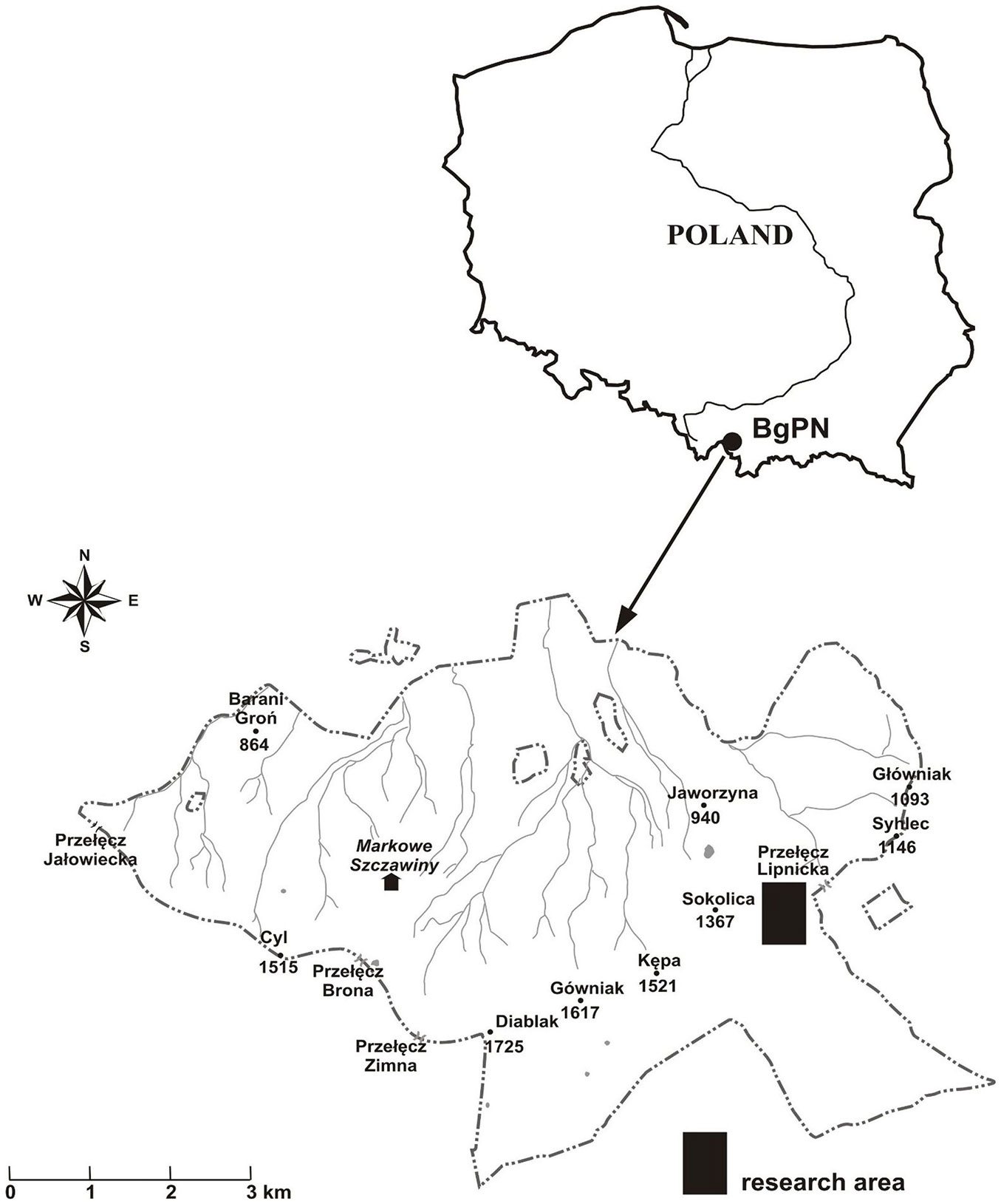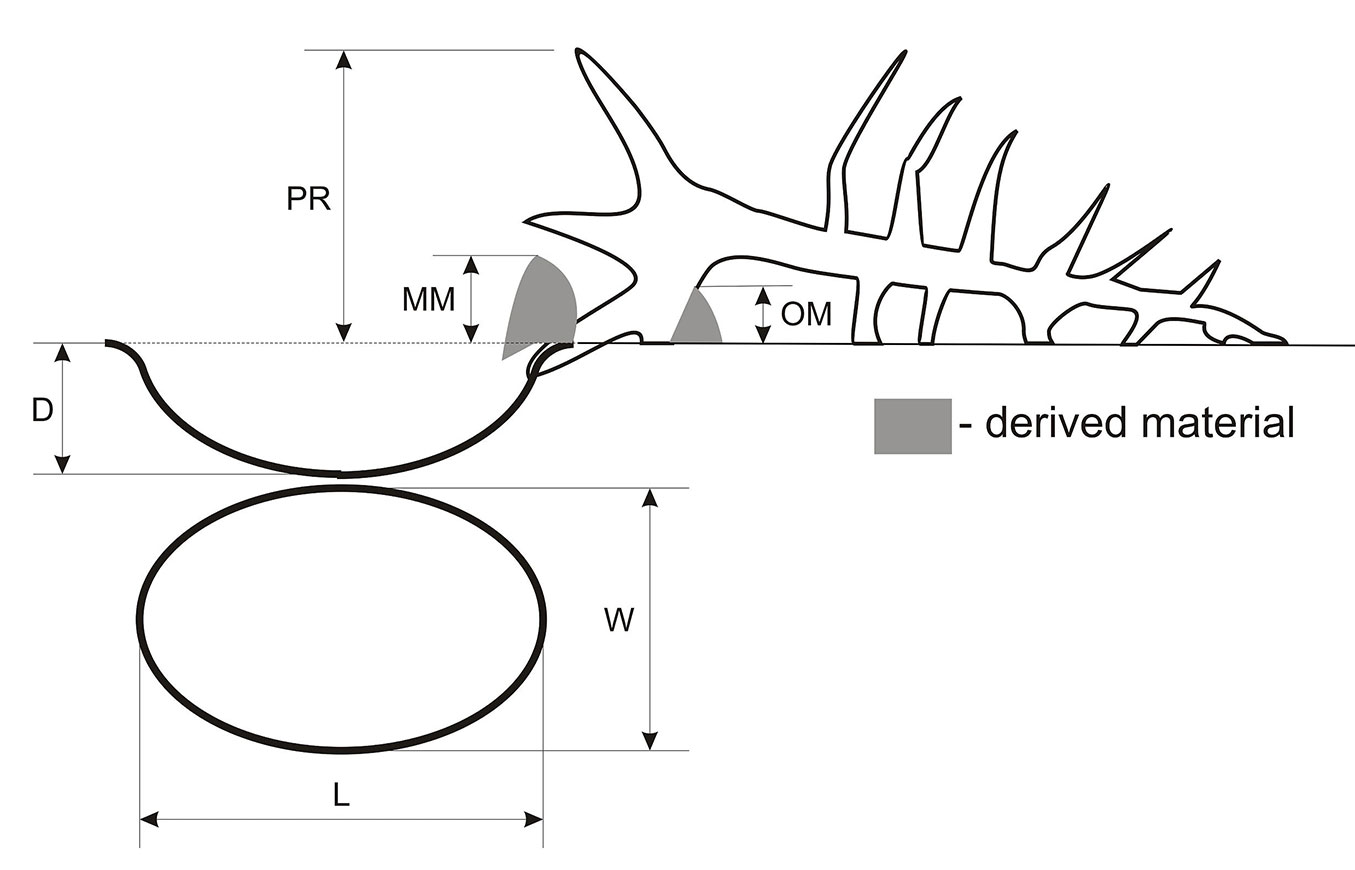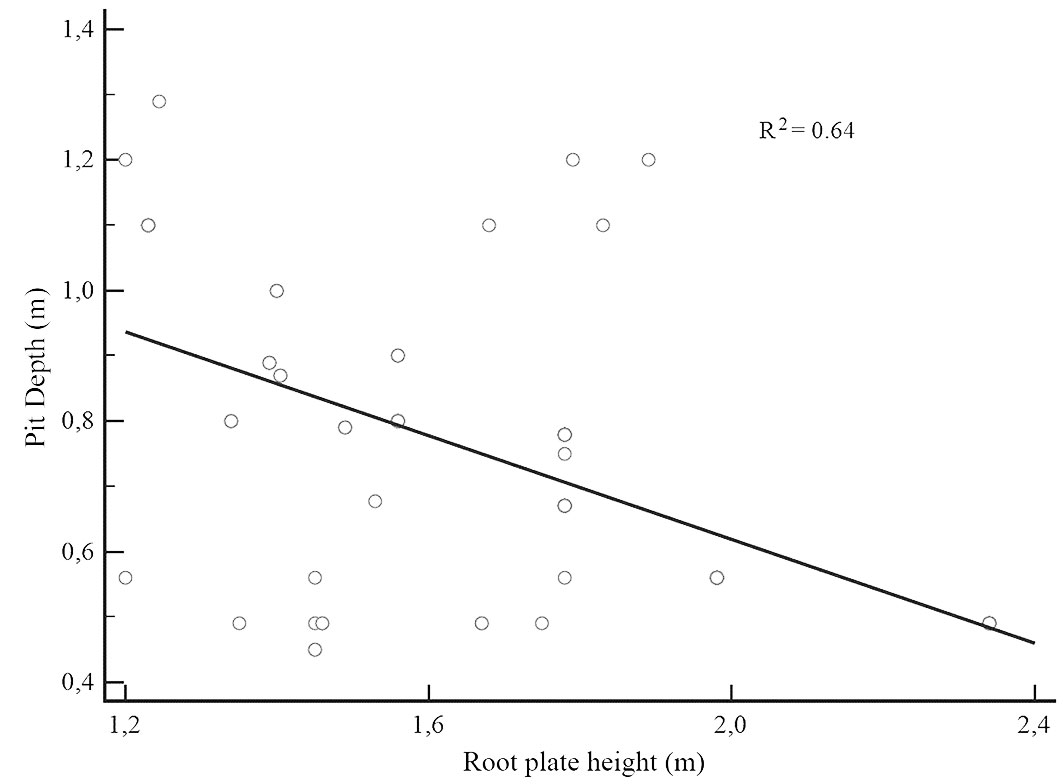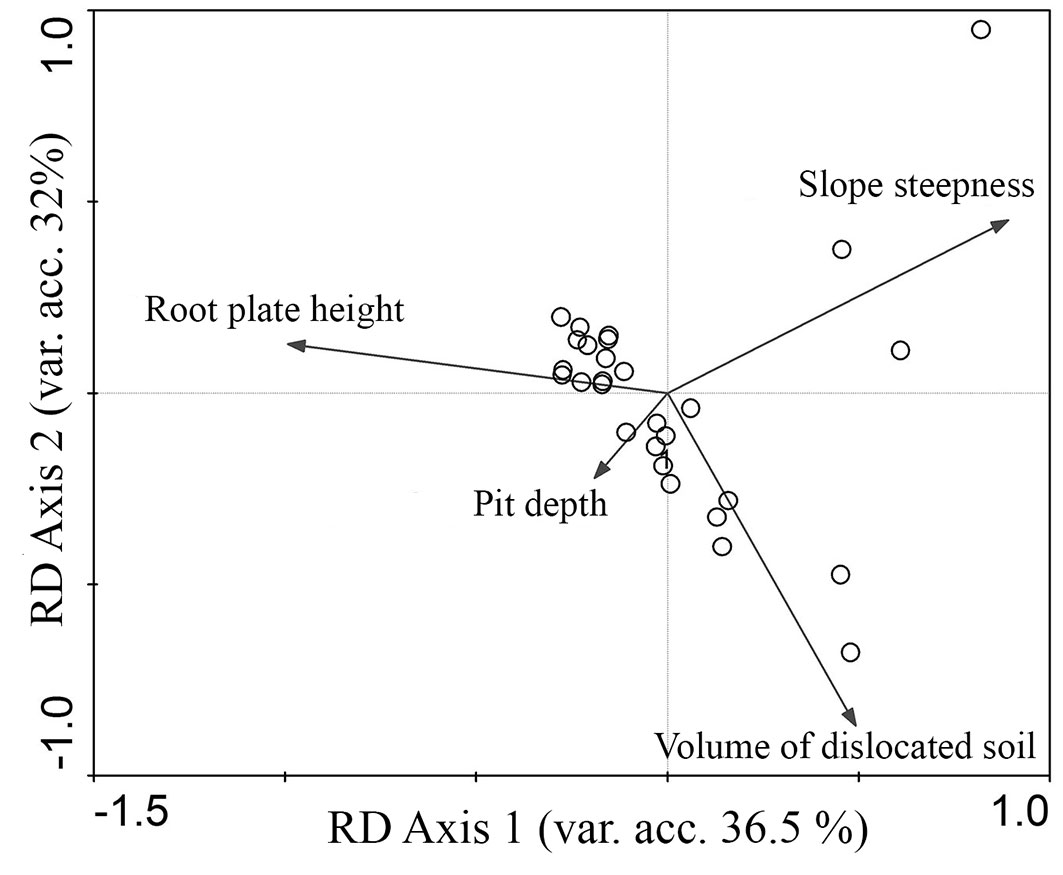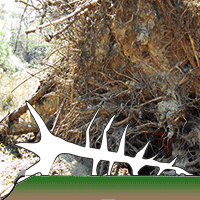
Vertical pit-mounds distribution of uprooted Norway spruce (Picea abies L.): field evidence in the upper mountain belt
iForest - Biogeosciences and Forestry, Volume 10, Issue 5, Pages 783-787 (2017)
doi: https://doi.org/10.3832/ifor1959-010
Published: Sep 02, 2017 - Copyright © 2017 SISEF
Short Communications
Abstract
Tree uprooting causes significant changes in forest habitat functioning and soil formation. In this paper soil uplifted by tree throws was compared among 15 study plots from heterogeneous Norway spruce stands of the upper mountain belt in southern Poland. Pit-mound microtopography parameters such as length, width, depth of tree-throw pits, height of the root plate, and height of mineral and organic mounds, were measured at each uprooting site. Sites were grouped in 3 age groups based on the time elapsed since uprooting. Results showed significant differences between the studied parameters among age groups. Differences were most pronounced in mean pit depth (0.52, 0.65 and 0.95 m for 5-year, 3-year, and 1-year-old pits, respectively). No significant interaction between age group and root plate height was detected by ANOVA. Regression analysis showed that pit depth decreases as root plate height increases. Redundancy analysis using pit-mound parameters as dependent variables revealed that root plate height along with slope steepness are good predictors of the volume of dislocated soil at tree-throw sites. Overall, our results suggest that the erosion expected at uprooting sites in mountain Norway spruce stands could be conveniently estimated by measuring their root plates. This may help estimate the impact of windthrow on soil microtopography and quantify its effects on soil disturbance in Norway spruce stands of the upper mountain belt.
Keywords
Bioturbation, Mountain Landscapes, Microtopography, Soil Disturbance, Tree Uprooting
Introduction
Tree uprooting in mountain forest may provoke a severe and pervasive alteration of soil profile ([27], [26], [31]) and habitat structure as well ([23], [10], [20]). Uprooted trees reallocate soil, biomass, carbon and nutrients ([29], [16], [3], [34], [22], [14]). For instance, in Norway Spruce (Picea abies L.), which is among the tree species most sensitive to mechanical erosion, tree throw may increase mineral weathering processes ([35], [28]). Such bioturbation is likely to be an important long-term factor in forest ecology and should be incorporated into long-term ecology research on forest stands ([3], [21]). The variation of biogeochemical parameters following uprooting events can affect soil formation and vegetational succession of these microhabitats ([1]). Further, climate change is likely to increase the occurrence of windthrow and uprooting events in the future ([5]).
The aim of the study was to investigate on the microtopography and soil quality parameters of exposed pit-mounds of uprooted trees in old-growth stands of Norway spruce in Poland. To this aim, the following questions were posed: (1) how the vertical stratification of pit-mounds affect the overall topography of hilltops throughout the landscape? (2) how episodes that cause soil dislocation are best characterised? (3) how the root plate height might be used to study soil disturbances in the mountain area? (4) How pit-mounds affect soil rejuvenation at the forest stand level across a range of sites, and how this effect can be characterised?
Materials and methods
Study site
Fieldwork was carried out in forest lots located in the Babia Góra National Park, southern Poland (Fig. 1), where strong local winds caused a number of uprooting events in November 2004. Thereafter, a long-term ecological study was performed in several microhabitats where the majorpart of natural mound formation was due to weathering processes. We selected a 0.7 ha study area in the upper mountain belt, with elevation ranging from 1135 to 1198 m a.s.l. Slope steepness varied from 10° to 40°. Soils are generally Skeletic Podzols, Dystric Skeletic Cambisols and Dystric Skeletic Regosols ([13]) that developed from weathered Magura formation sandstone. Forest stands of the upper mountain belt were dominated by Norway spruce, showing the following average stand characteristics: 110 year-old, diameter (dbh) 33 cm, 30 m in height and 575 m3 ha-1 of volume ([7]). Plant communities were classified as Plagiothecio-Piceetum (tatricum) association with Vaccinium myrtillus and Athyrium distentifolium undergrowth ([19]).
Sampling design and data collection
Five uprooted trees from each of 15 different study plots were selected all over the study area, totaling 75 uprooting sites. The selected sites were grouped in three age classes based on the time elapsed since the occurrence of tree uprooting (1, 3, or 5 years). This allowed to compare the changes in pit-mound microtopography over time.
The geometric parameters of pit-mounds micromorphology were evaluated according to Gabet et al. ([9]) and Samonil et al. ([30]). For each pit-mound the following parameters were measured: length (L), width (W), depth (D) of the tree-throw pits; height of the plate root (PR); height of the mineral mound (MM, the soil mineral material derived from the root plate); height of the organic mound (OM, the root plate-derived organic material - Fig. 2). The difference between the mineral (MM) and the organic (OM) mounds was taken as the thickness of the soil surface horizon (predominantly umbric epipedon in the study area - [13]). Moreover, the slope of each pit (which is considered a key erosion factor) was measured to assess the variation in microhabitat patterns through time. All the pit-mound variables were measured to investigate the susceptibility to mechanical erosion at the uprooting site.
Fig. 2 - Schematic representation of the pit-mound microtopographic parameters measured at each uprooting site. (L): tree-throw pit length; (W): pit width; (D): pit depth; (PR): root plate height; (MM): mineral mound height; (OM): organic mound height.
Statistical analysis
To explore the relationships between the erosion factors of hilltops and the soil disturbance factors of the pit-mounds, redundancy analysis (RDA) was performed using the software CANOCO for Windows® v. 4.5 ([33]). The predictor matrix was composed of 6 variables (pit length, pit width, pit depth, root plate height, MM height and OM height) for each of the 75 uprooting sites. The dependent variables were organized in a single matrix of 4 variables (pit depth, root plate height, slope steepness and volume of dislocated soil) for each of the 75 microsites. Resamples of residual data was performed to retain the structure of the interpolation. All variables were tested for normal distribution by applying the Shapiro-Wilk’s test (α = 0.05), and the homogeneity of variance among groups was verified by the Levene’s test (α = 0.05). Moreover, to assess the contribution of each variable to the overall correlation a non-parametric comparison for all pairs was conducted using the Steel-Dwaas test implemented in the JMP® software package (SAS® ver. 11.04, Cary, NC, USA) with α = 0.01. Furthermore, the relationship between root plate height and depth was explored through linear regression analysis.
ANOVA was applied to test for differences in pit-mound characteristics among different sites and age groups (i.e., elapsed time since uprooting). Data were analysed using the PaSt® software (Paleontological Statistics, ver. 3.0). Statistical differences were reported significant at P < 0.05.
Results
Pit-mound parameters
Results showed a general trend of decrease in root plate height (PR) over time (Tab. 1). On average, the height of root plate decreased by 0.37 m between 1-year-old and 3-year-old pit-mounds, and by 0.16 m between 3-year and 5-year old pit-mounds. In addition, a remarkable difference was found in both length and depth of the pit between 1-year and 3-year-old pit-mounds, where the average length of the pit decreased by 0.48 m and the depth by 0.30 m. Differences between the 3-year and 5-year-old pit-mounds appeared not as much large (0.06 m and 0.13 m for length and depth, respectively). The width of the pit showed a comparable trend; the average width between 1-year-old and 3-year-old pit-mounds decreased by 0.55 m, and decreased an average of 0.40 m between the 3- and 5-year-old pit-mounds.
Tab. 1 - Mean values (± standard error) of the parameters measured on the studied pit-mounds. Different letters in each row indicate significant differences between age classes after Tukey’s test (P<0.05).
| Pit-Mound Parameters |
Pit-mound age class | ||
|---|---|---|---|
| 1-year-old | 3-year-old | 5-year-old | |
| Pit length (m) | 2.74 ± 0.29a | 2.26 ± 0.05b | 2.18 ± 0.09b |
| Pit width (m) | 4.23 ± 0.24a | 3.68 ± 0.12b | 3.28 ± 0.28b |
| Pit depth (m) | 0.95 ± 0.09a | 0.65 ± 0.02b | 0.52 ± 0.12b |
| Root plate height (m) | 2.35 ± 0.15b | 1.98 ± 0.34b | 1.82 ± 0.45b |
| MM height (m) | 0.71 ± 0.22b | 0.42 ± 0.11b | 0.44 ± 0.19b |
| OM height (m) | 0.33 ± 0.09b | 0.32 ± 0.07b | 0.38 ± 0.08b |
A decrease of mineral mound (MM) height and a slight increase of organic mound (OM) height was also observed. On average, the height of the mineral mound in 3-year-old pit-mounds was 0.29 m lower than in 1-year-old pit mounds; however, this was very similar to the 5-year-old pit mounds. The height of the organic mounds in 1-year and 3-year-old pit-mounds was similar, whereas in the five-year-old pit-mounds it was slightly higher, by 0.06 m (Tab. 1).
ANOVA revealed no significant differences between age groups and interaction between age and root plate height (P > 0.05). However, statistically significant differences in microtopographic variables among pit-mounds were observed (Tab. 2).
Tab. 2 - Results of the ANOVA using pit-mounds microtopography parameters with their combined root plate parameters. F-values and P-values for pit-mound parameters with effect (age): 1-year, 3-year and 5-year-old. (df): degrees of freedom; (ns): not significant (P>0.05).
| Factors | Sum of squares |
df | F | P-value |
|---|---|---|---|---|
| Pit-mound | 10.63 | 14 | 3.29 | < 0.05 |
| Age class | 131.76 | 75 | 114.31 | ns |
| Root plate height × age class | 158.52 | 70 | 1.05 | ns |
| Error | 16.52 | 89 | - | - |
Soil dislocation
Linear regression analysis showed a significant negative relationship between pit depth and root plate height (R2 = 0.64 - Fig. 3), that is, shallower pits were associated with higher root plates.
Fig. 3 - Linear regression plot between pit depth and height of the root plate. The best fitting equation was as follows: y = -0.3758x + 2.049 (R2 = 0.64, p<0.05).
Results of the RDA analysis are summarized in Fig. 4. The first axis accounted for 32% of the total variance, while the second for 36.5%. Correlation between site topographic features and microtopography parameters of pit-mounds revealed that both pit depth and root plate height were negatively associated with slope steepness. Interestingly, the depth of the uprooted pit was negatively correlated with both axes.
Fig. 4 - Redundancy analysis (RDA) correlation triplot. Arrows and their length represent the incidence of each factor on pit-mound characteristics. The two represented axes accounted for 68.5 % of the total variance.
The results of the Steel-Dwaas test carried out revealed a significant (P<0.01) erosion of surface horizons in terms of volume of eroded soil, particularly on steep slopes (Fig. 4).
Discussion
Tree uprooting has a significant impact on pedogenetic processes, both rejuvenating the soils and hampering its formation ([32]). Indeed, uprooted trees may shape forest habitats in the upper mountain belt, where windthrows often largely affect the land cover.
In this study, no significant differences were found among age groups of tree-uprooting sites (P > 0.05), though pit-mound differences were significant after ANOVA (p<0.05 - Tab. 2). Previous studies have reported that the elapsed time since the uprooting event drives the dynamic of pit-mound microtopography ([31]). However, this tendency was not observed in our study.
Tree uprooting is an important factor affecting the regeneration in Norway spruce stands of the upper mountan belt, providing new microhabitats suitable for colonization of forest tree species ([32]). Indeed, we observed the presence of spruce saplings in surveyed plots, especially on bare soil microsites. Further, the presence of the root plate of uprooted trees in Norway Spruce stands may provide favorable conditions to new recruits in terms of wind protection. On the other hand, such new habitats are exposed to the ground vegetation, which is no more limited by the canopy cover, thus allowing the survival of a specific vegetation ([12]). Currently, most of the plant species observed in the studied plots are typical of the Plagiothecio-Piceetum (tatricum) association. However, at lower altitudes more complex situations can be found due to the existence of erosion processes originating from neighbouring hills ([2], [6]).
We initially assumed that all studied plots were exposed to erosion caused by the abundant rainfall typical of mountain climate. The results of the redundancy analysis confirmed such assumption, revealing that slope steepness has the largest impact on soil dislocation at the studied uprooting sites (Fig. 4). Soil dislocation is affected by a variety of microsite conditions, primarily the amount of formed soil and the surface horizons, but also the microclimatic conditions ([18], [28]). Displacement of soil causes incipient sediment aggregation and increases the rate of erosion ([15], [11], [17], [4]).
In this study, tree-throw pit depth decreased as the width of root plate increased (Fig. 3). Consequently, the volume of uplifted soil is also decreasing with root plate width, as pit volume is highly correlated with its depth. This was assumed to be caused by backward rotation of the uprooting tree. Based on our results, soil pit-mound parameters and soil thickness are appropriate predictors of soil dislocation by the uprooted tree, in agreement with previous studies ([27], [9], [24], [8], [25]).
Our results suggest that the effect of uprooted trees on soil dislocation in mountain Norway spruce stands could be conveniently estimated by measuring their root plates. This may help estimate the impact of windthrow on soil microtopography and quantify its effects on soil disturbance in hill slopes of mountainous areas.
Conclusions
Pit-mound microtopography is an appropriate indicator of soil formation in Norway spruce stands in the upper mountain belt. Length, width and depth of pits and height of root plates decreased with increasing the elapsed time since uprooting. A clear reduction in height of the mineral mounds occurred only between 1-year and 3-year-old pit-mounds, whereas the height of organic mounds was similar in all age groups.
In general, the effect of erosion in mountain Norway spruce stands depends on the amount of uplifted soil during the uprooting event. Our results suggest that the erosion expected at uprooting sites in Norway spruce stands of the upper mountain belt can be estimated by using the microtopographic parameters of the pit-mounds and the root plate height. However, further studies are needed to quantify the effects of the ground vegetation colonizing the uprooting sites on the erosion process in hilltop Norway spruce stands.
Acknowledgments
This research was financed by the Ministry of Science and Higher Education of the Republic of (Poland grant no. N N305 106534) in years 2008-2009. The authors would like to express their gratitude to the Authorities of the Babia Gora National Park for the help and supply of spatially referenced forest structure in this study.
References
Gscholar
Gscholar
Gscholar
Gscholar
Gscholar
Gscholar
Authors’ Info
Authors’ Affiliation
Michal Gasiorek
Pawel Nicia
Department of Soil Science and Soil Protection, University of Agriculture in Krakow, Al. Mickiewicza 21, 31-120 Kraków (Poland)
Department of Land Reclamation and Environmental Development, University of Agriculture in Krakow, Al. Mickiewicza 24/28, 30-059, Kraków (Poland)
Department of Biometry and Forest Productivity, Faculty of Forestry, University of Agriculture in Krakow, Al. 29 Listopada 46, 31-425 Krakow (Poland)
Babia Góra National Park, 34-223 Zawoja 1403 (Poland)
Corresponding author
Paper Info
Citation
Zadrozny P, Halecki W, Gasiorek M, Nicia P, Lamorski T (2017). Vertical pit-mounds distribution of uprooted Norway spruce (Picea abies L.): field evidence in the upper mountain belt. iForest 10: 783-787. - doi: 10.3832/ifor1959-010
Academic Editor
Matteo Garbarino
Paper history
Received: Dec 19, 2015
Accepted: Sep 01, 2017
First online: Sep 02, 2017
Publication Date: Oct 31, 2017
Publication Time: 0.03 months
Copyright Information
© SISEF - The Italian Society of Silviculture and Forest Ecology 2017
Open Access
This article is distributed under the terms of the Creative Commons Attribution-Non Commercial 4.0 International (https://creativecommons.org/licenses/by-nc/4.0/), which permits unrestricted use, distribution, and reproduction in any medium, provided you give appropriate credit to the original author(s) and the source, provide a link to the Creative Commons license, and indicate if changes were made.
Web Metrics
Breakdown by View Type
Article Usage
Total Article Views: 46296
(from publication date up to now)
Breakdown by View Type
HTML Page Views: 39507
Abstract Page Views: 2995
PDF Downloads: 2863
Citation/Reference Downloads: 16
XML Downloads: 915
Web Metrics
Days since publication: 3032
Overall contacts: 46296
Avg. contacts per week: 106.88
Article Citations
Article citations are based on data periodically collected from the Clarivate Web of Science web site
(last update: Mar 2025)
Total number of cites (since 2017): 1
Average cites per year: 0.11
Publication Metrics
by Dimensions ©
Articles citing this article
List of the papers citing this article based on CrossRef Cited-by.
Related Contents
iForest Similar Articles
Research Articles
Soil microorganisms at the windthrow plots: the effect of post-disturbance management and the time since disturbance
vol. 10, pp. 515-521 (online: 20 April 2017)
Research Articles
Short- and long-term natural regeneration after windthrow disturbances in Norway spruce forests in Bulgaria
vol. 11, pp. 675-684 (online: 23 October 2018)
Research Articles
Ecological factors affecting the recent Picea abies decline in Slovenia: the importance of bedrock type and forest naturalness
vol. 16, pp. 105-115 (online: 29 March 2023)
Research Articles
Post-fire effects and short-term regeneration dynamics following high-severity crown fires in a Mediterranean forest
vol. 5, pp. 93-100 (online: 30 May 2012)
Review Papers
Large-scale effects of forest management in Mediterranean landscapes of Europe
vol. 6, pp. 342-346 (online: 29 August 2013)
Research Articles
Windstorm disturbance triggers multiple species invasion in an urban Mediterranean forest
vol. 11, pp. 64-71 (online: 25 January 2018)
Research Articles
Post-fire recovery of Abies cephalonica forest communities: the case of Mt Parnitha National Park, Attica, Greece
vol. 11, pp. 757-764 (online: 15 November 2018)
Research Articles
Use of terrestrial laser scanning to evaluate the spatial distribution of soil disturbance by skidding operations
vol. 8, pp. 386-393 (online: 08 October 2014)
Research Articles
Influence of salvage logging on forest recovery following intermediate severity canopy disturbances in mixed beech dominated forests of Slovenia
vol. 9, pp. 430-436 (online: 07 January 2016)
Research Articles
Dynamics of soil organic carbon (SOC) content in stands of Norway spruce (Picea abies) in central Europe
vol. 11, pp. 734-742 (online: 06 November 2018)
iForest Database Search
Search By Author
Search By Keyword
Google Scholar Search
Citing Articles
Search By Author
Search By Keywords
PubMed Search
Search By Author
Search By Keyword

